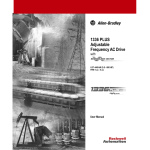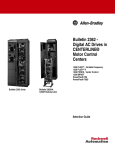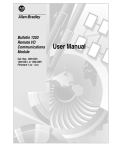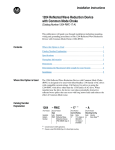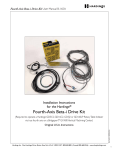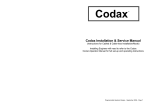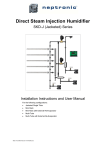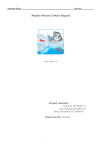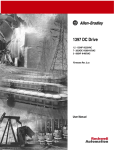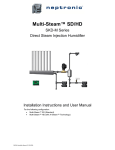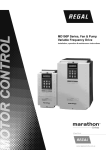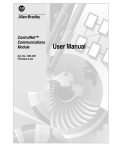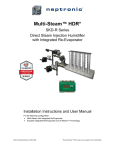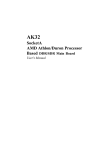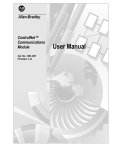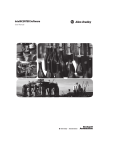Download Bulletin 2300 Family of Drive Systems Hardware - Can
Transcript
Bulletin 2300 Family of Drive Systems Hardware Installation Instructions Important User Information Solid state equipment has operational characteristics differing from those of electromechanical equipment. Safety Guidelines for the Application, Installation and Maintenance of Solid State Controls (Publication SGI-1.1 available from your local Rockwell Automation sales office or online at www.rockwellautomation.com/literature) describes some important differences between solid state equipment and hard-wired electromechanical devices. Because of this difference, and also because of the wide variety of uses for solid state equipment, all persons responsible for applying this equipment must satisfy themselves that each intended application of this equipment is acceptable. In no event will Rockwell Automation, Inc. be responsible or liable for indirect or consequential damages resulting from the use or application of this equipment. The examples and diagrams in this manual are included solely for illustrative purposes. Because of the many variables and requirements associated with any particular installation, Rockwell Automation, Inc. cannot assume responsibility or liability for actual use based on the examples and diagrams. No patent liability is assumed by Rockwell Automation, Inc. with respect to use of information, circuits, equipment, or software described in this manual. Reproduction of the contents of this manual, in whole or in part, without written permission of Rockwell Automation, Inc. is prohibited. Throughout this manual, when necessary we use notes to make you aware of safety considerations. ! WARNING: Identifies information about practices or circumstances that can cause an explosion in a hazardous environment, which may lead to personal injury or death, property damage, or economic loss. Important: Identifies information that is critical for successful application and understanding of the product. ! ATTENTION: Identifies information about practices or circumstances that can lead to personal injury or death, property damage, or economic loss. Attentions help you: • identify a hazard • avoid the hazard • recognize the consequences Shock Hazard labels may be located on or inside the equipment (e.g., drive or motor) to alert people that dangerous voltage may be present. Burn Hazard labels may be located on or inside the equipment (e.g., drive or motor) to alert people that surfaces may be at dangerous temperatures. 1336 FORCE, 1395, drove Tools, NRU, RGU, PLC-5 and CENTERLINE are registered trademarks of Rockwell Automation, Inc. DriveExplorer, DriveExecutive, and SCANport are trademarks of Rockwell Automation, Inc. PLC is a registered trademark of Rockwell Automation, Inc. Table of Contents Important User Information . . . . . . . . . . . . . . . . . . . . . . . . . . . . . . . . . . . . . . . . . . . . . . . 1-2 Summary of Changes Preface Overview Who Should Use This Manual . . . . . . . . . . . . . . . . . . . . . . . . . . . . . . . . . . . . . . . . . . . . . Purpose of This Manual . . . . . . . . . . . . . . . . . . . . . . . . . . . . . . . . . . . . . . . . . . . . . . . . . . How To Use This Manual . . . . . . . . . . . . . . . . . . . . . . . . . . . . . . . . . . . . . . . . . . . . . . . . . Safety Precautions . . . . . . . . . . . . . . . . . . . . . . . . . . . . . . . . . . . . . . . . . . . . . . . . . . . . . . . Contents of this Manual . . . . . . . . . . . . . . . . . . . . . . . . . . . . . . . . . . . . . . . . . . . . . . . . . . Related Documentation . . . . . . . . . . . . . . . . . . . . . . . . . . . . . . . . . . . . . . . . . . . . . . . . . . . Common Conventions Used In This Manual . . . . . . . . . . . . . . . . . . . . . . . . . . . . . . . . . . . . . . . . . . . . . . . . . . . . . . . . . Receiving Your Drive System . . . . . . . . . . . . . . . . . . . . . . . . . . . . . . . . . . . . . . . . . . . . . . Rockwell Automation Support . . . . . . . . . . . . . . . . . . . . . . . . . . . . . . . . . . . . . . . . . . . . . Chapter 1 P-1 P-1 P-1 P-2 P-3 P-4 P-5 P-5 P-6 Installing MCC Sections Introduction . . . . . . . . . . . . . . . . . . . . . . . . . . . . . . . . . . . . . . . . . . . . . . . . . . . . . . . . . . . . 1-1 Before You Begin . . . . . . . . . . . . . . . . . . . . . . . . . . . . . . . . . . . . . . . . . . . . . . . . . . . . . . . 1-1 Preparing the System for Bus Splice Installation . . . . . . . . . . . . . . . . . . . . . . . . . . . . . . . 1-1 Preparing the Inside of an MCC: Panel-Mounted Units . . . . . . . . . . . . . . . . . . . . . . . . . 1-9 Putting the MCC Sections in Place . . . . . . . . . . . . . . . . . . . . . . . . . . . . . . . . . . . . . . . . . 1-10 Bolting Together Newly-Joined MCC Sections . . . . . . . . . . . . . . . . . . . . . . . . . . . . . . . 1-10 Splicing the Busbars Together. . . . . . . . . . . . . . . . . . . . . . . . . . . . . . . . . . . . . . . . . . . . . 1-12 Completing an MCC After Bus Splice Installation. . . . . . . . . . . . . . . . . . . . . . . . . . . . . 1-12 Chapter 2 Removing and Installing Bucket Units Introduction . . . . . . . . . . . . . . . . . . . . . . . . . . . . . . . . . . . . . . . . . . . . . . . . . . . . . . . . . . . . Before You Begin . . . . . . . . . . . . . . . . . . . . . . . . . . . . . . . . . . . . . . . . . . . . . . . . . . . . . . . Removal Procedure . . . . . . . . . . . . . . . . . . . . . . . . . . . . . . . . . . . . . . . . . . . . . . . . . . . . . . Installation Procedure . . . . . . . . . . . . . . . . . . . . . . . . . . . . . . . . . . . . . . . . . . . . . . . . . . . . Chapter 3 Removing and Installing Roll-Out Chassis Units Introduction . . . . . . . . . . . . . . . . . . . . . . . . . . . . . . . . . . . . . . . . . . . . . . . . . . . . . . . . . . . . Before You Begin . . . . . . . . . . . . . . . . . . . . . . . . . . . . . . . . . . . . . . . . . . . . . . . . . . . . . . . Removal Procedure . . . . . . . . . . . . . . . . . . . . . . . . . . . . . . . . . . . . . . . . . . . . . . . . . . . . . . Installation Procedure . . . . . . . . . . . . . . . . . . . . . . . . . . . . . . . . . . . . . . . . . . . . . . . . . . . . Chapter 4 2-1 2-1 2-2 2-5 3-1 3-1 3-2 3-5 Removing and Installing MCC Doors Introduction . . . . . . . . . . . . . . . . . . . . . . . . . . . . . . . . . . . . . . . . . . . . . . . . . . . . . . . . . . . . Before You Begin . . . . . . . . . . . . . . . . . . . . . . . . . . . . . . . . . . . . . . . . . . . . . . . . . . . . . . . Removing an MCC Door . . . . . . . . . . . . . . . . . . . . . . . . . . . . . . . . . . . . . . . . . . . . . . . . . Installing an MCC Door . . . . . . . . . . . . . . . . . . . . . . . . . . . . . . . . . . . . . . . . . . . . . . . . . . 4-1 4-1 4-1 4-2 2 Chapter 5 Installing Busbar Splices Introduction . . . . . . . . . . . . . . . . . . . . . . . . . . . . . . . . . . . . . . . . . . . . . . . . . . . . . . . . . . . . 5-1 Before You Begin. . . . . . . . . . . . . . . . . . . . . . . . . . . . . . . . . . . . . . . . . . . . . . . . . . . . . . . . 5-1 Splicing Power Busbars . . . . . . . . . . . . . . . . . . . . . . . . . . . . . . . . . . . . . . . . . . . . . . . . . . . 5-2 Splicing Control Busbars . . . . . . . . . . . . . . . . . . . . . . . . . . . . . . . . . . . . . . . . . . . . . . . . . 5-12 Installing the Equipment Grounding Conductor (PE) Bus Splice . . . . . . . . . . . . . . . . . . . . . . . . . . . . . . . . . . . . . . . . . . . . . . . . . . . . . . . . . . . . 5-15 Installing the Zero Potential (TE) Bus Splice . . . . . . . . . . . . . . . . . . . . . . . . . . . . . . . . . 5-16 Chapter 6 Installing Top Hat Assemblies and Cutting Holes for Cable Entry/Exit Introduction . . . . . . . . . . . . . . . . . . . . . . . . . . . . . . . . . . . . . . . . . . . . . . . . . . . . . . . . . . . . 6-1 Installing a Top Hat Assembly. . . . . . . . . . . . . . . . . . . . . . . . . . . . . . . . . . . . . . . . . . . . . . 6-1 Appendix A Busbar Splice Kit Catalog Numbers Introduction . . . . . . . . . . . . . . . . . . . . . . . . . . . . . . . . . . . . . . . . . . . . . . . . . . . . . . . . . . . . A-1 Understanding Catalog Numbers. . . . . . . . . . . . . . . . . . . . . . . . . . . . . . . . . . . . . . . . . . . . A-1 Busbar Splice Kit Catalog Numbers . . . . . . . . . . . . . . . . . . . . . . . . . . . . . . . . . . . . . . . . . A-2 Index Summary of Changes Changes made to this manual, since the last release, include: 1 For this updated information: See: Revised torque values on bus clamps 5-5, 5-6, 5-9 and 5-11 Publication 20D-UM002C-EN-P - November 2003 2 Notes: Publication 20D-UM002C-EN-P - November 2003 Preface Overview Please read this preface to familiarize yourself with this manual. This preface covers the following topics: • who should use this manual • the purpose of this manual safety precautions • contents of this manual • related documentation conventions used in this manual • drive system receiving • Rockwell Automation support Who Should Use This Manual This manual is intended for those who are responsible for installing Rockwell Automation drive systems. ! ATTENTION: If you do not have a basic understanding of the drive system, as designed, or of any product(s) used in the system, contact your local Rockwell Automation representative for information on available training courses before starting the system. Purpose of This Manual This manual provides installation instructions for Rockwell Automation’s Bulletin 2300 family of drive systems. The provided procedures are for those tasks that need to be done at the customer site before system startup. How To Use This Manual When using this manual to install your drive system, you will begin and complete the installation in Chapter 1 of this manual. Chapter 1 will refer you to other chapters that address specific unit configuration instructions and busbar splice installation instructions. When you are referred to another chapter–go to that chapter, perform the required procedure(s), and then return to Chapter 1. Note: You can also refer to the appropriate chapter of this manual whenever you need to: • remove/install bucket units • remove/install roll-out chassis units • remove/install an MCC door p-2 Safety Precautions The following general precautions apply when installing, servicing, or operating Bulletin 2300 drive system lineups: ! ATTENTION: Only those familiar with the drive system, the products used in the system, and the associated machinery should plan or implement the installation, startup, and future maintenance of the system. Failure to comply can result in personal injury and/or equipment damage. ATTENTION: Verify that all sources of AC and DC power are deenergized and locked out or tagged out in accordance with the requirements of ANSI/NFPA 70E, Part II. ATTENTION: The system may contain stored energy devices. To avoid the hazard of electrical shock, verify that all voltage on capacitors has been discharged before attempting to service, repair, or remove a drive system or its components. You should only attempt the procedures in this manual if you are qualified to do so and are familiar with solid-state control equipment and the safety procedures in ANSI/NFPA 70E. ATTENTION: An incorrectly applied or incorrectly installed drive system can result in component damage and/or a reduction in product life. Wiring or application errors–such as undersizing the motor, incorrect or inadequate AC supply, and excessive ambient temperatures–can result in the malfunction of the drive equipment. ATTENTION: This drive system contains parts and assemblies that are sensitive to ESD (electrostatic discharge). Static control precautions are required when installing, testing, or repairing this assembly. Component damage can result if ESD control procedures are not followed. If you are not familiar with static control procedures, refer to Allen-Bradley publication 8000-4.5.2, Guarding Against Electrostatic Damage, or another adequate handbook on ESD protection. p-3 Contents of this Manual Chapter Title Contents Preface Purpose, background, and scope of this manual. 1 Installing MCC Sections Procedures for installing CENTERLINE™ MCC cabinet sections. 2 Removing and Installing Bucket Units Procedures for removing and installing bucket units. 3 Removing and Installing Roll-Out Chassis Units Procedures for removing and installing roll-out chassis units. 4 Removing and Installing MCC Doors Procedures for removing and installing a door on an MCC cabinet. 5 Installing Busbar Splices Procedures for installing power, control, PE, and TE bus splices. 6 Installing Top Hat Assemblies and Cutting Holes for Cable Entry/Exit Procedures for installing top hat assemblies and cutting holes in MCCs. A Busbar Splice Kit Catalog Numbers A list of busbar splice kits with catalog numbers. p-4 Related Documentation The following documents include information that may be helpful when installing or services components in your drive system. To obtain a copy of any of the Rockwell Automation publications, contact your local Rockwell Automation office or distributor. For Read This Document Document Number Information on the 1336 FORCE™ drives 1336T User Manual – AC Drives 1336 FORCE-5.12 Information on the 1336 PLUS™ drives 1336S User Manual – .05-600HP 1336 PLUS-5.0 Information on low-kVA 1395™ drives 1395 Installation Manual – Digital DC Drive 1395-5.40 Information on medium-kVA 1395 drives 1395 Installation Manual – Digital DC Drive in Motor 1395-5.60 Control Center Information on high-kVA 1395 drives 1395 Installation Manual – Digital DC Drive in Bulletin 2361 Motor Control Center 2361-5.01 PLC-5™ information PLC-5 Controllers Brochure 1785-1.2 Additional information on joining and splicing together MCCs Instructions – Joining and Splicing Vertical Sections 2100-5.1 Details on receiving, handling, and storing MCCs Instructions – Receiving, Handling, and Storing Motor Control Centers 2100-5.5 Information on 2364E non-regenerative front-end units (NRU™) NRU User Manual 2364E-5.01 Information on 2364F regenerative front-end units (RGU™) RGU User Manual 2364F-5.01 A description of DriveTools™ software DriveTools Software Brochure 9303-1.0 Articles on wire sizes and types for grounding electrical equipment National Electrical Code (NFPA 70) Published by NFPA of Boston, MA; ANSI/NFPA70 Articles on safety procedures Standard for Electrical Safety Requirements for the NFPA 70E Employee Workplace Instruction for handling, installing, operating, and maintaining motor control centers Instructions for the Handling, Installation, Operation, NEMA ICS 2.3 and Maintenance of Motor Control Centers A complete listing of current Allen-Bradley documentation, including ordering instructions. Also indicates whether the documents are available on CD-ROM or in multi-languages Allen-Bradley Publication Index SD499 A glossary of industrial automation terms and abbreviations Allen-Bradley Industrial Automation Glossary AG-7.1 p-5 Common Conventions Used The following conventions are used throughout this manual: In This Manual • Bulleted lists such as this provide information, not procedural steps. • Numbered lists provide sequential steps or hierarchical information. • When we refer you to another section/document, that name appears in italics. • The exclamation point inside a triangle followed by the word “ATTENTION” indicates circumstances that can lead to personal injury, death, property damage, or economic loss. Receiving Your Drive System You, the customer, are responsible for thoroughly inspecting the equipment before accepting the shipment from the freight company. Check the item(s) that you receive against your purchase order. If any items are obviously damaged, do not accept the delivery until the freight agent has noted the damage on the freight bill. Should you discover any concealed damage during unpacking, you are responsible for notifying the freight agent. In such a case, leave the shipping container intact and request that the freight agent make a visual inspection of the equipment. p-6 Rockwell Automation Support Rockwell Automation offers support services worldwide, with Sales/ Support Offices, authorized distributors, and authorized Systems Integrators located throughout the United States, plus Rockwell Automation representatives in every major country in the world. Local Product Support Please contact your local Rockwell Automation representative for: • sales and order support • product technical training • warranty support • support service agreements Technical Product Assistance If you need to contact us for technical assistance, please review the product information in the appropriate product manual first. Then call your local Rockwell Automation representative. For the quickest possible response, we recommend that you have the catalog numbers of your products available when you call. Chapter 1 Installing MCC Sections Introduction This chapter provides procedures for installing CENTERLINE Bulletin 2100 motor control center sections. Before You Begin Before you begin installation, be sure you have the following: • The MCC sections containing the drive system • Tool(s) you will need to: – remove and tighten screws: slotted screw slotted/phillips screw #10 thread-forming hexhead screw (0.312” across flats) ¼” thread-forming screw (0.375” across flats) – remove and tighten bolts: ¼” bolt (0.438” across flats) ½” bolt (0.750” across flats) – secure screws with nuts: ¼”-20 nut (0.438” across flats) Preparing the System for Bus Splice Installation Follow these procedures to prepare the MCC sections for installation: Important: Physical restrictions at your installation site may not allow the following sequences to be followed exactly as stated. Unpacking the MCC Sections 1. Remove the MCCs from their packaging. Important: Be sure to handle the MCCs according to the instructions provided in CENTERLINE Motor Control Centers (AB Publication 2100-5.5). 2. Remove all splice kits and labels from wireways, blank unit spaces, and other external packaging. Note: A label on the outside of a compartment designates the location of splice kits located within a horizontal wireway or blank unit space. Note: Keep track of splice kits. Misplaced splice kits may not have immediate replacements available. 1-2 Preparing the Outside of an MCC For each MCC that is to be joined to an adjacent MCC, do the following: 1. Remove the MCC’s lower wireway cover, if presently attached, by unfastening 2 screws. See Figure 1.1. Figure 1.1 Removing an MCC’s Lower Wireway Cover Lower Wireway Cover Front View 1-3 2. Remove the four end-cover plates, if present, from the sides of MCCs that will be joined to other MCCs. Unfasten the 4 screws that secure each plate. This will expose joining holes. See Figure 1.2. Figure 1.2 Removing the End Covers and Power Bus Plate Side View (R.H.) Upper End Covers Power Bus Plate Lower End Covers 3. Remove the power-bus plates, if present, from the sides of MCCs that will be adjacent to other MCCs. To remove a power bus plate, unfasten 10 screws. Refer to Figure 1.2. 1-4 4. Remove all screws and plastic plugs from joining holes. Refer to Figure 1.3 for hole locations. Figure 1.3 Location of Joining Holes Side View (R.H.) Joining Hole Joining Hole Joining Hole Joining Hole Joining Hole Joining Hole Joining Hole 1-5 Preparing the Inside of an MCC For each MCC that is to be joined to an adjacent MCC, do the following: If the MCC contains a: Typical Units Go to: Roll-out chassis unit 2362 (D-G frame units), 2364F (K-N codes) Preparing the Inside of an MCC: Roll-Out Chassis Units (see page 1-6) Bucket units 2362 (A-C frame units) Preparing the Inside of an MCC: Bucket Units (see page 1-7) Panel-mounted unit 2361 units, 2364E units, 2364F (J-code units) Preparing the Inside of an MCC: Panel-Mounted Units (see page 1-9) 1-6 Preparing the Inside of an MCC: Roll-Out Chassis Units 1. If the MCC contains a: Then: A 2362 (D-G frame) or 2364F (K-N code) roll out chassis unit. Follow the procedures in Chapter 3 to remove the roll-out chassis from the MCC. 2. Remove the horizontal bus access cover, if not already removed, to expose the bus ends for splicing. Each horizontal bus access cover is secured with two screws. Reference Figure 1.4. Figure 1.4 Removing the Horizontal Bus Access Cover in an MCC that Contains a Roll-Out Chassis Unit Hole s Holes N otch Notch No tch Notch Horizontal Bus Access Cover 3. Pull all bottom-entry cables, if present, through the conduit(s) to a spot where you can reach them after you have put the MCCs in place. 1-7 Preparing the Inside of an MCC: Bucket Units 1. If the MCC will be spliced on: Then: Right side Loosen 3 screwlatches to open the vertical wireway door on the right side. See Figure 1.5. Left side Follow the procedures in Chapter 2 to remove any buckets blocking access to the horizontal bus and joining holes. Figure 1.5 Removing the Vertical Wireway Door Vertical Wireway Door Left Side Right Side 1-8 2. Remove the splice-opening cover on the joining side of the MCC. Refer to Figure 1.6. Figure 1.6 Removing the Splice-Opening Cover Splice Opening Cover 3. Pull all bottom-entry cables, if present, through the conduits to a spot where you can reach them after you have put the MCCs in place. 1-9 Preparing the Inside of an MCC: Panel-Mounted Units 1. Remove the horizontal bus access cover from the joining side of the MCC, as indicated in Figure 1.7. Figure 1.7 Removing the Horizontal Bus Access Cover from an MCC Containing a Panel-Mounted Unit Horizontal Bus Access Cover 2. Pull all bottom-entry cables, if present, through the conduit(s) to a spot where you can reach them after you have put the MCCs in place. 1-10 Putting the MCC Sections in Use the following procedure to put the MCC sections in place: Place 1. Move the MCC sections into place according to the instructions provided in CENTERLINE Motor Control Centers (AB Publication 2100-5.5). 2. Level the MCCs. 3. Fasten the MCCs to the floor. Note: Each MCC has two holes for securing the MCC to the floor with 1/2” bolts. These two holes are located in the center front and center rear of each MCC bottom. Follow this procedure for bolting together newly-joined MCC sections: Bolting Together Newly-Joined MCC Sections Important: Use the hardware furnished with the power bus splice kits. 1. Verify that the following hardware is present for each pair of sections to be bolted together: 2. At every hole labeled “A” on Figure 1.8, pass a thread-forming screw from inside the left-hand section and engage the screw with the respective hole in the right-hand section. 3. At the hole labeled “B” on Figure 1.8, pass the 1/4-20 x 5/8” hex-head screw from inside the left-hand section through the respective hole in the right-hand section and secure with the flat washer and steel nut. 1-11 Figure 1.8 Labeled Locations of Joining Holes Side View (L.H.) A Side View (R.H.) A A A A B A Back A B A A A A A Back 1-12 Splicing the Busbars Together After all MCC sections have been bolted together, do the following: ! ATTENTION: This drive contains ESD (Electrostatic Discharge) sensitive parts and assemblies. Status control precautions are required when installing, testing, or repairing this assembly. Component damage can result if ESD control procedures are not followed. If you are not familiar with static control procedures, refer to Allen-Bradley publication 8000-4.5.2, Guarding Against Electrostatic Damage, or any other applicable ESD protection handbook. 1. Install busbar splices according to the procedures in Chapter 5. 2. Inspect the interior for dust and dirt. Vacuum as needed. Important: Do not clean using compressed air because it contains moisture and may blow debris into the control equipment. 3. Verify that no tools or hardware have been dropped inside the MCCs. Completing an MCC After Bus Splice Installation Follow this procedure for each MCC that you have joined to an adjacent MCC. Table 1.A Completing the Inside of an MCC If the MCC contains a: Typical Units Go to: Roll-out chassis unit 2362 (D-G frame units), 2364F (K-N codes) Completing the Inside of an MCC: Roll-Out Chassis Units (see page 1-13) Bucket units 2362 (A-C frame units) Preparing the Inside of an MCC: Bucket Units (see page 1-13) Panel-mounted unit 2361 units, 2364E units, 2364F (J-code units) Preparing the Inside of an MCC: Panel-Mounted Units (see page 1-13) 1-13 Completing the Inside of an MCC: Roll-Out Chassis Units 1. Install the horizontal bus access cover. Each horizontal bus access cover is secured with two screws (see Figure 1.4). 2. If the MCC contains a: Then: A 2362 (D or E-frame) or 2364F (K or L-code) roll out chassis unit. 1.Follow the procedures in Chapter 3 to install the roll-out chassis from the MCC. 2.Go to Completing the Output of an MCC (page 1-14). A 2362 (F or G-frame) or 2364F (M or N-code) roll-out chassis unit. Go to Completing the Outside of an MCC (page 1-14). Completing the Inside of an MCC: Bucket Units 1. Install the splice-opening cover on the joining side of the MCC (see Figure 1.6). 2. If the MCC will be spliced on: Then: Right side 1.Close the vertical wireway door and secure the door by tightening the 3 screwlatches (Figure 1.5). 2.Go to Completing the Outside of an MCC. Left side 1.Follow the procedures in Chapter 2 to remove any buckets that were removed. 2.Go to Completing the Outside of an MCC (page 1-14). Completing the Inside of an MCC: Panel-Mounted Units 1. Install the horizontal bus access cover (see Figure 1.7). 2. Go to Completing the Outside of an MCC. 1-14 Completing the Outside of an MCC For all MCCs that were just joined to adjacent MCCs, do the following: 1. Position the MCC’s lower wireway cover. 2. Fasten the two screws that secure the lower wireway cover to the MCC (see Figure 1.1). Chapter 2 Removing and Installing Bucket Units Introduction This chapter provides procedures for removing and installing bucket units. Before You Begin Before you begin installation, be sure you have the following: • Tool(s) you will need to: – disconnect and connect wires – loosen and tighten slotted screwlatches that secure the bucket to the MCC 2-2 Removal Procedure Follow the procedure below to remove bucket units from an MCC: ! ATTENTION: To avoid the hazard of electrical shock, verify that all voltages on the system bus network have been discharged before attempting to service the system. 1. Open the door of the MCC. Note: Removal of the door is not necessary. 2. If: Then: You want to remove the door Follow the door removal procedure in Chapter 4. If: Then: The unit to be removed is less than 2 space factors Disengage the screwlatches at the front of the bucket unit – one at the top and one at the bottom. See Figure 2.1. Otherwise Disengage the screwlatches at the front of the bucket unit – two at the top and one at the bottom. See Figure 2.1. 3. Figure 2.1 Screwlatch Locations Screwlatch Screwlatch 2-3 4. Disconnect all wires that connect the module to stationary devices in the MCC. Important: If any of these wires remain intact, you will not be able to freely remove the module from the MCC. ! ATTENTION: The 2362 A-frame bucket weighs approximately 45 pounds (21 kg); the B-frame bucket weighs approximately 90 pounds (41 kg); and the C-frame bucket weighs approximately 140 pounds (64 kg). Failure to take precautions when moving a bucket may result in personal injury and/or damage to equipment. ATTENTION: Do not force the bucket when removing it from the MCC. If you cannot easily remove the bucket, verify that all necessary wires have been disconnected. ATTENTION: After the bucket has been removed from the MCC, secure the bucket so that it will not tip over or fall, causing personal injury and/or equipment damage. 5. Disconnect customer wiring at the bottom of the bucket and slide the wiring into the vertical wireway. 2-4 6. Pull the bucket forward to unplug from the vertical bus, holding the upper right-hand latch assembly and the lower left-hand tab handle. See Figure 2.2. Figure 2.2 Bucket Connections Top View of Enclosure Back Vertical Bus Vertical Ground Vertical Wireway L1 L2 L3 PE Front Top View of Bucket Note: Figure 2.2 shows the configuration for a common-AC-bus system. For a common-DC-bus system, the middle vertical bus and clip (L2) shown above are not present. 2-5 Installation Procedure Follow the procedure below to install a bucket unit into an MCC: ATTENTION: To avoid the hazard of electrical shock, verify that all voltages on the system bus network have been discharged before attempting to service the system. ! ATTENTION: The 2362 A-frame bucket weighs approximately 45 pounds (21 kg); the B-frame bucket weighs approximately 90 pounds (41 kg); and the C-frame bucket weighs approximately 140 pounds (64 kg). Failure to take precautions when moving a bucket may result in personal injury and/or damage to equipment. 1. Open the door of the MCC. 2. Verify that the bucket and vertical bus are either DC or AC (both the bucket and vertical bus should have L1, L2, and L3; or L1 and L3 only). See Figure 2.3. Figure 2.3 Valid Bucket Connections DC Vertical Bus 3-Phase AC Vertical Bus Yes Yes L1 L2 L1 L3 Bucket No L3 Bucket No 3. Push the bucket backward to plug into the vertical bus, holding the upper right-hand latch assembly and the lower left-hand tab handle (Figure 2.2 shows how the bucket will plug into the vertical power and ground buses). 2-6 4. Connect customer wiring at the bottom of the bucket, as appropriate. 5. Connect all wires that connect the module to stationary devices in the MCC. 6. If: Then The unit to be removed is less than 2 space factors Engage the screwlatches at the front of the bucket unit – one at the top and one at the bottom. See Figure 2.1. Otherwise Engage the screwlatches at the front of the bucket unit – two at the top and one at the bottom. See Figure 2.1. 7. If the door has been removed, follow the door installation procedure found in Chapter 4. Chapter 3 Removing and Installing Roll-Out Chassis Units Introduction This chapter provides the necessary steps to remove and install roll-out chassis units. Before You Begin Before you begin installation, be sure you have the following: • Tool(s) you will need to: – disconnect and connect wires – remove and tighten screws: #10 thread-forming hexhead screw (0.312” across flats) ¼” thread-forming screw (0.375” across flats) – remove and tighten bolts: 3/8” bolt (0.563” across flats)–for D/F-frame 2362 units and K-code 2364F units M10 bolt (17 mm across flats)–for G-frame 2362 units and M/N-code 2364F units • A means to remove the roll-out chassis unit 3-2 Removing and Installing Roll-Out Chassis Units Removal Procedure Follow the procedure below to remove roll-out chassis units from an MCC. ATTENTION: To avoid the hazard of electrical shock, verify that all voltages on the system bus network have been discharged before attempting to service the system. ! 1. Open door of MCC. 2. Remove two screws to detach the lower wireway cover, if presently attached. Refer to Figure 3.1. Figure 3.1 Removing the Lower Wireway Cover Example of Typical Shipping Brace Lower Wireway Cover (TYP) 3. Remove shipping brace (if present). 4. Remove a total of four screws to detach both of the lower reinforcing angles as shown in Figure 3.2 (used in D, E, F-frame 2362 units and in K and L-code 2364F units). Removing and Installing Roll-Out Chassis Units 3-3 5. If the sealing angle (shown in Figure 3.2) obstructs the roll-out chassis from rolling out, remove the sealing angle. 6. For G-frame 2362 units and M or N-code 2364F units, remove the lower brace, which is shown in Figure 3.2. 7. Remove both of the lower mounting angles, as shown in Figure 3.2, by unfastening four screws each (used in D, E, and F-frame 2362 units, and in K and L-code 2364F units). Figure 3.2 Typical Mounting Hardware By Unit E-frame 2362, F-frame 2362 or L-code 2364F D-frame 2362 or K-code 2364F G-frame 2362, M-code 2364F, or N-code 2364F Upper Mounting Bracket Upper Mounting Bracket Mounting Angle (Typ. 2) Reinforcing Angle (Typ. 2) Lower Brace Sealing Angle 3-Dimensional View Mounting Angle Reinforcing Angle 3-4 Removing and Installing Roll-Out Chassis Units 8. If the module size is: Do this: D, F, or G-frame 2362 units or K, M, or N-code 2364F units Remove a total of two bolts to unfasten the chassis unit from the upper brackets. Refer to Figure 3.2. E-frame 2362 units or L-code 2364F units Remove a total of four screws to unfasten the chassis unit from the upper brackets. Refer to Figure 3.2. 9. Disconnect all wires that connect the chassis unit to stationary devices in the MCC. Important: If any of these wires remain intact, you will not be able to freely remove the chassis unit from the MCC. ! ATTENTION: 2362 chassis units have the following approximate weights: D-frame, 260 lbs (119 kg); E-frame, 440 lbs (200 kg); F-frame 675 lbs (306 kg); and G-frame 1000 lbs (455 kg). 2364F chassis units have the following approximate weights: K-code, 260 lbs (119 kg); L-code, 440 lb (200 kg); M-code, 1000 lbs (455 kg); and N-code, 1000 lbs (455 kg). Failure to take precautions when moving a chassis unit may result in personal injury and/or damage to equipment. ATTENTION: Do not force the chassis unit when removing it from the MCC. If you cannot easily remove the chassis unit, verify that all necessary wires have been disconnected. ATTENTION: After the chassis unit has been removed from the MCC, secure the chassis unit so that it will neither tip over nor fall, causing personal injury and/or equipment damage. 10.Carefully remove the chassis unit from the MCC according to your company’s handling instructions. Removing and Installing Roll-Out Chassis Units Installation Procedure 3-5 Follow the procedures below to install a roll-out chassis unit into its MCC. ! ATTENTION: To avoid the hazard of electrical shock, verify that all voltages on the system bus network have been discharged before attempting to service the system. ATTENTION: 2362 chassis units have the following approximate weights: D-frame, 260 lbs (119 kg); E-frame, 440 lbs (200 kg); F-frame 675 lbs (306 kg); and G-frame 1000 lbs (455 kg). 2364F chassis units have the following approximate weights: K-code, 260 lbs (119 kg); L-code, 440 lb (200 kg); M-code, 1000 lbs (455 kg); and N-code, 1000 lbs (455 kg). Failure to take precautions when moving a chassis unit may result in personal injury and/or damage to equipment. 1. Reposition the chassis unit into the MCC according to your company’s handling instructions. 2. Connect all wires that you disconnected between the chassis unit and devices in the MCC. 3. If the module size is: Do this: D, F, or G-frame 2362 units or K, M, or N-code 2364F units Replace the two bolts to fasten the chassis unit to the upper brackets. See Figure 3.2. E-frame 2362 units or L-code 2364F units Replace the four screws to fasten the chassis unit to the upper brackets. See Figure 3.2. 3-6 Removing and Installing Roll-Out Chassis Units 4. Fasten four screws to attach the lower mounting angles (see Figure 3.2). 5. For G-frame 2362 units and M or N-code 2364F units, fasten the two screws to attach the lower brace 6. If the sealing angle has been removed, fasten the two screws to attach the sealing angle (see Figure 3.2). 7. Install four screws to attach both of the lower reinforcing angles. 8. Fasten two screws to attach the lower wireway cover (shown in Figure 3.2). Chapter 4 Removing and Installing MCC Doors Introduction This chapter provides the necessary steps to remove and install MCC doors. Before You Begin Before you begin your installation, be sure you have the following: • Tool(s) you will need to: – remove a door hinge (i.e. - standard screwdriver) – disconnect door-mounted devices Removing an MCC Door ! ATTENTION: The system may contain stored energy devices. To avoid the hazard of electrical shock, verify that all voltage on capacitors has been discharged before attempting to service, repair, or remove a drive system or its components. You should only attempt the procedures in this manual if you are qualified to do so and are familiar with solid-state control equipment and the safety procedures in publication NFPA 70E. Follow this procedure to remove an MCC door: 1. Open door completely. 2. Disconnect door-mounted devices, as appropriate. Important: Before disconnecting, be sure to note the assembly/wiring of devices and re-label wire labels if they cannot be easily read. 3. Remove hinge pins by sliding them up out of the hinge. You can use a screwdriver to make pin removal easier. 4. Swing door carefully to a nearly closed position. 5. Lift door up and off. 4-2 Installing an MCC Door Follow this procedure to install an MCC door: 1. With door in a nearly-closed position, place door onto hinges in its proper orientation. 2. Carefully open door completely. 3. Replace hinge pins by sliding them into hinges. 4. Connect door-mounted devices per your notes. Chapter 5 Installing Busbar Splices Introduction This chapter provides the necessary steps to install power, control, equipment grounding conductor (PE), and zero potential (TE) bus splices. Before You Begin Before you begin your installation: 1. Verify that MCCs have been joined together as specified by instructions provided in Chapter 1. 2. Be sure you have the following: • One PE / TE (equipment grounding conductor / zero potential) bus splice kit for every two sections just joined. • One control bus splice kit, if both sections have a control bus, for every two sections just joined. • One power bus splice kit for every two sections just joined. • Tool(s) you will need to: – tighten screws: 1/4” thread-forming screw (0.375” across flats) – torque bolts: 1/4” bolt (0.438” across flats) – secure screws and nuts: 1/4” nut (0.438” across flats) 3/8” nut (0.563” across flats) 5-2 Splicing Power Busbars Follow the procedures contained in this section to splice the two halves of each power bus in every pair of MCCs that you have joined together. Note: A common-DC-bus system will have 2 separate power busses; and a common-AC-bus system will have 3 separate power busses. The following table will help you to determine the type of power bus splice that needs to be installed. This table addresses the various bus configurations available in a 20-inch-deep MCC, the standard depth used by Rockwell Automation Drive Systems. If: Then: Both ends of the power bus to be joined are at a depth of either 11.92 inches (303 mm) or 16.92 inches (430 mm): 1. Reference Figure 5.1(a). 2. Go to Installing Straight Power Bus Splices. One end of the power bus to be joined is at 1. Reference Figure 5.1(b). a depth of 11.92 inches (303 mm); the 2. Go to Installing Straight Power Bus Splices. other 16.92 inches (430 mm): 5-3 Figure 5.1 Top Views of Various Power Bus Splice Configurations! a. Both Ends of the Power Bus at the Same Depth Front Front b. One End of the Power Bus at a Depth of 11.92 inches (303 mm); the Other, 16.92 inches (430 mm) Front Front ! All views show a dual busbar configuration. In a single busbar configuration, only a single splice is used. Installing Straight Power Bus Splices If each power bus consists of: Then go to: A single bar Installing Straight Power Bus Splices: Single Bar Two bars Installing Straight Power Bus Splices: Dual Bar 5-4 Installing Straight Power Bus Splices: Single Bar 1. Verify that the following splice hardware is present: Description Common DC Bus Quantity Common AC Bus Quantity 8-hole, straight busbar splice 2 3 Bus clamps! 8 12 Flat washer 16 24 Nut/conical-spring washer 16 24 ! For each busbar end with built-in clamps, decrease the required quantity by 2. ! ATTENTION: Verify that the busbar splices are of the same thickness as the busbars to be spliced. For lineups containing common bus F-frame 2362 units, any G-frame 2362 units, or M/N-code 2364F units, the bus splices should be sized to match the overall bus rating of the lineup. See Figure 1.15 for an example. Figure 5.2 Splicing with G-Frame 2362 Units or M/N-Code 2364F Units–Example G-frame Unit Other Unit on the Common Bus Select the appropriate clamps for each connection according to the table below. Clamp Length 1.75” 2.00” 2.25” Use When Splicing 800A (0.13”) or 1200A (0.25”) bus 1600A (0.5”) bus 2000A (0.63”) or 3000A (0.75”) bus Bus Section Rated 800-3000A Bus Splice Rated 800A Bus Section Rated 800A In this example, the overall bus is rated for 800A. 5-5 2. Verify that contact surfaces are free of dirt/debris. Deburr edges as necessary. 3. Insert the bus clamps, from the backside, through the holes at the ends of the busses to be joined. Refer to Figure 5.3. Note: Bus clamps will only fit into the busbar holes in the vertical orientation. Figure 5.3 Installing a Straight Power Bus Splice, Single Bar Power Bus Bus Clamp (Back) Flat Washer Splice Bar One-Piece Nut and Conical Washer (Front View) 4. Slide one busbar splice over the ends of the bus clamps as shown in Figure 5.3. 5. Slide one flat washer and one nut/conical-spring washer over the end of each bus-clamp screw. 6. Torque all bus clamps to 38 lb-ft ± 2 lb-ft (52 N-m ± 3 N-m). 5-6 Installing Straight Power Bus Splices: Dual Bar For each power bus in the system, follow this procedure: 1. Verify that the following splice hardware is present: Description Common DC Bus Quantity Common AC Bus Quantity 8-hole, straight busbar splice 4 6 Bus clamps! 8 12 Flat washer 16 24 Nut/conical-spring washer 16 24 ! For each busbar end with built-in clamps, decrease the required quantity by 2. ! ATTENTION: Verify that the busbar splices are of the same thickness as the busbars to be spliced. For lineups containing common bus F-frame 2362 units, any G-frame 2362 units, or M/N-code 2364F units, the bus splices should be sized to match the overall bus rating of the lineup. See Figure 1.15 for an example. 2. Verify that contact surfaces are free of dirt/debris. Deburr edges as necessary. 3. If: Then: Either bus has a built-in bus clamp 1. Insert the bus clamps, from the backside, through the holes at the ends of the busses without built-in bus clamps. See Figure 5.3(a). 2. Slide two busbar splices over the ends of the bus clamps on the front-side of the bus. Neither bus has a built-in bus clamp 1. Position one busbar splice behind the bus as shown in Figure 5.3(b). 2. Insert the bus clamps, from the backside, through the busbar splice and bus. 3. Slide the second busbar splice over the ends of the bus clamps. 4. Slide one flat washer and one nut/conical-spring washer over the end of each bus-clamp screw. 5. Torque all bus clamps to 38 lb-ft ± 2 lb-ft (52 N-m ± 3 N-m). 5-7 Figure 5.4 Installing a Straight Power Bus Splice with Dual Bars a. When a Power Bus has a Built-In Bus Clamp Built-In Bus Clamp Power Bus Bus Clamp (Back) Flat Washer Splice Bars One-Piece Nut and Conical Washer (Front View) b. When Neither Power Bus has a Built-In Bus Clamp Power Bus Bus Clamp (Back) Flat Washer Splice Bars One-Piece Nut and Conical Washer (Front View) 5-8 Installing Offset Power Bus Splices If each power bus consists of: Then go to: A single bar Installing Offset Power Bus Splices: Single Bar Two bars Installing Offset Power Bus Splices: Dual Bar Installing Offset Power Bus Splices: Single Bar For each power bus in the system, follow this procedure: 1. Verify that the following splice hardware is present: Description Common DC Bus Quantity Common AC Bus Quantity 8-hole, offset busbar splice 2 3 Bus clamps! 8 12 Flat washer 16 24 Nut/conical-spring washer 16 24 ! For each busbar end with built-in clamps, decrease the required quantity by 2. 2. ! ATTENTION: Verify that the busbar splices are of the same thickness as the busbars to be spliced. For lineups containing common bus F-frame 2362 units, any G-frame 2362 units, or M/N-code 2364F units, the bus splices should be sized to match the overall bus rating of the lineup. See Figure 5.2 for an example. 3. Verify that contact surfaces are free of dirt/debris. Deburr edges as necessary. 4. Insert the bus clamps as indicated in Figure 5.5. 5-9 Figure 5.5 Installing a Single Bar Offset Power Bus Splice Busbar (Back) Bus Clamp Flat Washer Splice Bar One-Piece Nut and Conical Washer Busbar (Front View) 5. Position one busbar splice as shown in Figure 5.5. 6. Slide one flat washer and one nut/conical-spring washer over the end of each bus-clamp screw. 7. Torque all bus clamps to 38 lb-ft ± 2 lb-ft (52 N-m ± 3 N-m). 5-10 Installing Offset Power Bus Splices: Dual Bar For each power bus in the system, follow this procedure: 1. Verify that the following splice hardware is present: Description Common DC Bus Quantity Common AC Bus Quantity 8-hole, offset busbar splice 4 6 Bus clamps! 8 12 Flat washer 16 24 Nut/conical-spring washer 16 24 ! For each busbar end with built-in clamps, decrease the required quantity by 2. ! ATTENTION: Verify that the busbar splices are of the same thickness as the busbars to be spliced. 2. Verify that contact surfaces are free of dirt/debris. Deburr edges as necessary. 3. Insert the bus clamps as indicated in Figure 5.6. 5-11 Figure 5.6 Installing a Dual Bar Offset Power Bus Splice Busbar (Back) Bus Clamp Flat Washer Splice Bars One-Piece Nut and Conical Washer Busbar (Front View) 4. Position one busbar splice as shown in Figure 5.6. 5. Slide one flat washer and one nut/conical-spring washer over the end of each bus-clamp screw. 6. Torque all bus clamps to 38 lb-ft ± 2 lb-ft (52 N-m ± 3 N-m). 5-12 Splicing Control Busbars Follow the procedures contained in this section to join the two halves of both control busses in ever pair of MCCs that needs to be spliced together. The following table will help you to determine the type of control bus splice that needs to be installed. This table addresses the various bus configurations available in a 20-inch-deep MCC, the most popular depth used by Rockwell Automation Drive Systems. If: Then go to: Both ends of the control bus to be joined are at a depth of either 11.92 inches (303 mm) or 16.92 inches (430 mm): Installing Straight Control Bus Splices One end of the control bus to be joined is at a depth Installing Offset Control Bus Splices of 11.92 inches (303 mm); the other, 16.92 inches (430 mm): 5-13 Installing Straight Control Bus Splices Use this procedure if bus ends are at the same depth: 1. Verify that the following splice hardware is present: Description Quantity 2-hole, straight busbar splice 2 1/4-20 x 3/4” hex-head screw 4 Flat washer 4 Lockwasher 4 2. Slide one lock washer and one flat washer onto a screw. 3. Repeat 2 once. 4. Position one busbar splice in front of the discontinuity in the upper control bus. Reference Figure 5.7. Figure 5.7 Installing a Straight Control Bus Splice Threaded Insert L1 Flat Washer Lock washer Hex-Head Screw 120 V AC N Straight Control Bus Splice 5. Align the two elongated hoes of the straight control busbar splice over the two holes bordering the discontinuity in the upper control bus. 6. Fasten the straight control busbar splice to the upper control bus, from the front, using the same two hex head screws. 7. Torque both hex head screws to 108 lb-in (12.2 N-m). 8. Repeat 2 through 7 to splice together the lower control bus. 5-14 Installing Offset Control Bus Splices Use this procedure if bus ends are offset in depth: 1. Verify that the following splice hardware is present: Description Quantity 2-hole, offset busbar splice 2 1/4-20 x 3/4” hex-head screw 4 Flat washer 4 Lockwasher 4 2. Slide one lock washer and one flat washer onto one screw. 3. Repeat 2 once. 4. Position one offset control busbar splice in front of the discontinuity in the upper control bus. Reference Figure 5.8. Figure 5.8 Installing an Offset Control Bus Splice Threaded Insert Flat Washer Lock washer L1 Hex-Head Screw 120 V AC Straight Control Bus Splice N 5. Align the two elongated holes of the offset control busbar splice over the two holes bordering the discontinuity in the upper control bus. 6. Fasten the offset control busbar splice to the upper control bus, from the front, using the same two screws. 7. Torque screws to 108 lb-in (12.2 N-m) 8. Repeat 2 through 7 to splice together the lower control bus. 5-15 Installing the Equipment Grounding Conductor (PE) Bus Splice 1. Verify that the following splice hardware is present: Description Quantity 1/4” x 1” busbar splice 2 1/4-20 x 3/4” thread-forming screw 4 2. Position one busbar splice in front the discontinuity in the PE bus. Reference Figure 5.9. 3. Note: When you look into the front of an MCC, the PE bus is located behind the TE bus. 4. Align the two elongated holes of the busbar splice over the two holes bordering the discontinuity in the PE bus. 5. Fasten the busbar splice to the PE bus, from the front, using thread-forming screws. Note: If the system has a 3000 Amp-rated power bus, repeat steps 2 through 4 to install a second busbar splice. The two splices should be installed such that one splice spans the upper half of the PE bus; the second splice spans the lower half. Figure 5.9 Installing the PE Bus Splice TE/PE Bus Splice Thread-Forming Screw 5 2 6* PE (Used with 800-2000A rated power bus) TE Note: If the system has a 3000A rated power bus, repeat steps 2 through 4 to install a second busbar splice. The two splices should be installed such that one splice spans the upper half of the PE bus; and the second splice spans the lower half. PE (Used with 3000A rated Power Bus) Splices 5-16 Installing the Zero Potential (TE) Bus Splice Note: If the MCCs to be joined do not have a TE bus, discard the hardware for splicing together the TE bus and disregard this procedure. 1. Verify that the following splice hardware is present: Description Quantity 1/4” x 1” busbar splice 1 1/4” x 1” hex-head screw 2 Flat washer 4 Lockwasher 2 1/4” nut 2 2. Slip one flat washer onto one hex-head screw. See Figure 5.10. 3. Repeat 2 once. 4. Position the busbar splice in front of the discontinuity in the TE bus. 5. Align the two elongated holes of the busbar splice over the two holes bordering the discontinuity in the TE bus. 6. Slide the same two hex-head screws through both the busbar splice and the TE bus, from the front. 7. To each hex-head screw, slide on one flat washer, one lock washer, and one nut. 8. Torque both hex-head screws to 108 lb-in (12.2 N-m). Figure 5.10 Installing the TE Bus Splice Nut Lock washer Flat Washer 5 6* 2 TE/PE Bus Splice Flat Washer Hex-Head Screw Chapter 6 Installing Top Hat Assemblies and Cutting Holes for Cable Entry/Exit Introduction This chapter provides the necessary steps for installing top hat assemblies onto Bulletin 2300 enclosures and the necessary steps for properly cutting holes in Bulletin 2300 enclosures for cable entry or exit. Installing a Top Hat Assembly Before you begin your installation, be sure to have the following: • All the items of the top hat assembly to be installed • Tool(s) you will need to: – cut holes into MCC enclosures – loosen, tighten, and torque #10-32 screws Note: The longer screws in the kit will be used to fasten the bottom plate of the assembly to the top of the MCC. ! ATTENTION: Remove all power sources to the motor control center before installing the top hat assembly. Contact with energized parts can cause injury or death. 1. Remove the top plate from the MCC (this will be used as the top plate for the top hat assembly). 2. Attach the back plate to the side frames (items shown in Figure 6.1). Torque to 32 lb-in (3.6 N-m). 3. Place the bottom plate onto the MCC. 4. Place the assembly onto the bottom plate and secure to the MCC with the longer screws in the kit. Torque to 32 lb-in (3.6 N-m). 5. Attach the left side plate, right side plate, and front plate to the assembly. Torque to 32 lb-in (3.6 N-m). 6. Follow the instructions on page 6-3 to cut entry holes into the top plate. 7. Attach the top plate to the assembly. Torque to 32 lb-in (3.6 N-m). 6-2 Figure 6.1 Top Hat Assembly Top Plate (From MCC) Side Frames Back Plate Right Side Plate Left Side Plate Front Plate Bottom Plate 6-3 Cutting Holes for Cable Entry/Exit Before you begin your installation, be sure to have the following: • Appropriate product documentation • Tool(s) you will need to: – cut holes into MCC enclosures – loosen, tighten, and torque #10-32 screws 1. Determine where to punch holes for cable entry/exit. Important: Figure 6.1 shows the typical clearance available for cable entry/ exit in the MCC. For top hat assemblies, the top plate may be cut anywhere within the 1.25 inch border. Figure 6.2 Cutting Holes in a Top Plate–Clearance Area 1.25 inches (31.75mm) 1.25 inches (31.75mm) See below for 25-inch deep section. Area Available for Cable Entry/Exit Do not cut top plate in grayed area. 6.5 inches (165 mm) Note: Custom MCC sections may not include a wireway tray, or may include a wireway tray less than 6.5 inches deep. Check your MCC section for the appropriate clearance. Notes for 25-inch Deep Section Bumpback Area (5” deep) Top plate is only 20” deep. 6.25 inches (159 mm) 6-4 2. Remove the top plate from the MCC. 3. Punch the desired holes into the top plate. Remove all debris from the top plate. 4. Secure the top plate to the MCC. Torque to 32 lb-in (3.6 N-m). Appendix A Busbar Splice Kit Catalog Numbers Introduction This appendix provides a description of busbar splice kit catalog numbers. Understanding Catalog Numbers Each character of the catalog number identifies a specific type of size of a particular busbar splice kit The first four numbers represent the family of products (for example, 2300). The remaining characters represent a specific version. Determining Catalog Numbers To help you to understand, we will provide an example of how to determine a catalog number for a Bulletin 2300 busbar splice kit. The beginning portion of the catalog number for all 2300 busbar splice kits is 2300H (H is for a hardware kit). The remaining portion of the catalog number represents the particular type of kit. The catalog number is organized as follows: 2300 H - SK Busbar Type - Busbar Splice Shape Power Bus Current Rating For example, a catalog number on the following page for 2300H-SKA-Z16 would mean: • a common-AC power bus system • a power bus rating of 1600 Amps • an offset splice is needed A-2 Busbar Splice Kit Catalog Numbers Power Bus Splice Kit Catalog Numbers If: Then select the appropriate kit from: You are splicing directly to a common AC bus F-frame, any G-frame 2362 unit, or any M or N-code 2364F unit Table B Otherwise Table A Table A.A Power Bus Splice Kits Power Bus Power Bus Rating (Amps) AC Common Bus Straight Splice Kit DC Common Bus Offset Splice Kit Straight Splice Kit Offset Splice Kit 2300H-SKD-L08 2300H-SKD-Z08 2300H-SKD-L16 2300H-SKD-Z16 2300H-SKD-L30 2300H-SKD-Z30 800 2300H-SKA-L08 2300H-SKA-Z08 1200 2300H-SKA-L12 2300H-SKA-Z12 1600 2300H-SKA-L16 2300H-SKA-Z16 2000 2300H-SKA-L20 2300H-SKA-Z20 3000 2300H-SKA-L30 2300H-SKA-Z30 Table A.B Special Power Bus Splice Kits For Splicing to a Common AC Bus F-Frame 2362 Unit, Any G-Frame 2362 Unit, or Any M or N-Code 2364F Unit Power Bus Power Bus Rating AC Common Bus DC Common Bus (Amps) Straight Splice Kit Offset Splice Kit Straight Splice Kit Offset Splice Kit 800-3000 2300H-SKA-L30S 2300H-SKA-Z30 2300H-SKD-L30S 2300H-SKD-Z30 Control Bus Splice Kit Catalog Numbers Table A.C Control Bus Splice Kits Power Bus Rating Control Bus (Amps) 800-3000 Straight Splice Kit Offset Splice Kit 2300H-SKC-L 2300H-SKC-Z PE/TE Bus Splice Kit Catalog Numbers Table A.D PE/TE Bus Splice Kits Power Bus Rating (Amps) 800-3000 PE/TE Bus Splice Kit 2300H-SKG-30 Index A A-frame bucket weight, 2362 2-3, 2-5 doors, MCC installing 4-2 removal 4-1 drive system, receiving P-5 B B-frame bucket weight, 2362 2-3, 2-5 bucket units completing inside 1-13 connections 2-4 installation procedure 2-5 preparing inside 1-7 removal procedure 2-2 weights 2-3, 2-5 bus access cover, removing panel-mounted units 1-9 roll-out chassis units 1-6 busbars splicing 1-12 E E-frame chassis weight, 2362 3-4, 3-5 end covers, removing 1-3 equipment grounding conductor (PE) 5-15 F F-frame chassis weight, 2362 3-4, 3-5 G G-frame chassis weight, 2362 3-4, 3-5 offset control busbar 5-14 offset power busbar, dual bar 5-10 offset power busbar, single 5-8 PE (equipment grounding conductor) H horizontal bus access cover installing panel-mounted unit 1-13 roll-out chassis unit 1-13 removing panel-mounted unit 1-9 roll-out chassis unit 1-6 5-15 power busbar 5-2 straight control busbar 5-13 straight power busbar, dual bar 5-6 straight power busbar, single bar 5-4 TE (zero potential conductor) 5-16 J joining holes, location 1-4 K K-code chassis weight, 2364F 3-4, 3-5 L C catalog numbers table of numbers A-2 understanding numbers A-1 C-frame bucket weight, 2362 2-3, 2-5 conventions, manual P-5 L-code chassis weight, 2364F 3-4, 3-5 lower reinforcing angles installing 3-5 lower wireway cover installing 1-14 removing 1-2, 3-2 cutting holes for cable entry/exit 6-3 M D D-frame chassis weight, 2362 3-4, 3-5 M-code chassis weight, 2364F 3-4, 3-5 Index-2 Motor Control Center (MCC) installation bolting sections together 1-10 completing inside 1-12 completing outside 1-14 preparation, inside 1-5 preparation, outside 1-2 putting sections in place 1-10 sections, unpacking 1-1 tools required for 1-1, 2-1, 3-1 N N-code chassis weight, 2364F 3-4, 3-5 P panel mounted units preparing inside 1-9 panel-mounted units completing inside 1-13 U upper brackets securing chassis to 3-5 W weight A-frame bucket, 2362 2-3, 2-5 B-frame bucket, 2362 2-3, 2-5 C-frame bucket, 2362 2-3, 2-5 D-frame chassis, 2362 3-4, 3-5 E-frame chassis, 2362 3-4, 3-5 F-frame chassis, 2362 3-4, 3-5 G-frame chassis, 2362 3-4, 3-5 K-code chassis, 2364F 3-4, 3-5 L-code chassis, 2364F 3-4, 3-5 M-code chassis, 2364F 3-4, 3-5 N-code chassis, 2364F 3-4, 3-5 wireway cover, removing 1-2, 3-2 PE (equipment grounding conductor) 5-15 power bus plate, removing 1-3 power bus splice configurations 5-3 precautions, safety P-2 R reference publications P-4 reinforcing angles installing 3-5 roll-out chassis units completing inside 1-13 installing 3-5 preparing inside 1-5 weights 3-4, 3-5 S safety precautions P-2 screwlatch locations 2-2 splice opening cover installing 1-13 removing 1-8 support services P-6 T TE (zero potential conductor) 5-16 top hat assembly, installing 6-1 Z zero potential conductor (TE) 5-16 Publication 2300-5.1 – November 2004 Supersedes 2300-5.1 dated March 1999 P/N 342290 Copyright © 2004 Rockwell Automation, Inc. All rights reserved. Printed in USA.




































































